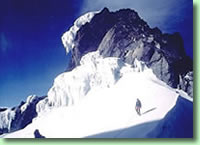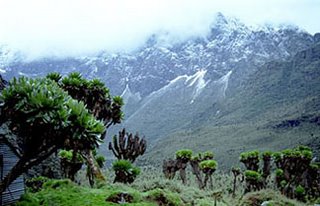
Those
nattering nabobs of negativism are at it again. You know,
scientists. Not got a speck of mirth in the lot of them:
Mountain glaciers in equatorial Africa are on their way to disappearing within two decades, a team of British researchers reports.
Located in the Rwenzori Mountains on the border between Uganda and the Democratic Republic of Congo, the glaciers will be gone within 20 years if current warming continues, the researchers report in this week's online edition of Geophysical Research Letters.
More seriously, my remarks, I mean, I have written about a similar issue before, but with
Kilimanjaro as the subject. The article did not specify global climate or local climate and, ultimately, that is very difficult to distinguish when there are other local factors in play, like deforestation:
Satellite images of Kilimanjaro did indeed show that the snow on that mountain has very nearly disappeared. And while Kilimanjaro has long been considered a thermometer of world climate, [Dr.] Christian pointed out that the mountain was also subjected to a severe alteration of its local environment and that remote sensing clearly showed that the forest belt surrounding the mountain has been decimated over the last 40 years. Such a loss of forest belt would result in localised warming. In short, because of a severe alteration of the local environment, loss of ice mass on Kilimanjaro could not be used as a reliable indicator of any trend in global climate change. This is something that people using Kilimanjaro as evidence of global warming should become aware of, because it is not reliably the case. It was something I had also believed until I saw Christian's talk. (For a fantastic satellite image of Kilimanjaro, check this out.)

I would be surprised if the forests around the Rwenzori Mountains, the so-called
Mountains of the Moon, have not also suffered a similar fate as those surrounding Kilimanjaro. Though the mountain region is quite extensive, it is reported that
Rwenzori forests have been fragmented:
Moreover, the population density of the area surrounding the park, already very high (between 150 and 430 persons/sq.km), is increasing and the consequent denudation and erosion of the foothills outside the park boundary continues. The Park was closed to visitors in 2000 as civil unrest still made it unsafe for people and animals and the local people still saw it as a major source of resources while the Park staff had no means of dealing with either challenge. Illegal logging, poaching and trafficking in small animals especially by local armed groups remain common. (UNESCO,2000)
Since both global warming and local deforestation will have occurred practically in parallel (both related, ultimately, to population growth) determining that "an increase in air temperatures in recent decades" has happened doesn't tell us much that we didn't already know; the heating in the African highlands is being doubly hit by both a local and a global warming trend.
 Those nattering nabobs of negativism are at it again. You know, scientists. Not got a speck of mirth in the lot of them:
Those nattering nabobs of negativism are at it again. You know, scientists. Not got a speck of mirth in the lot of them: I would be surprised if the forests around the Rwenzori Mountains, the so-called Mountains of the Moon, have not also suffered a similar fate as those surrounding Kilimanjaro. Though the mountain region is quite extensive, it is reported that Rwenzori forests have been fragmented:
I would be surprised if the forests around the Rwenzori Mountains, the so-called Mountains of the Moon, have not also suffered a similar fate as those surrounding Kilimanjaro. Though the mountain region is quite extensive, it is reported that Rwenzori forests have been fragmented:

0 Comments:
Post a Comment
<< Home